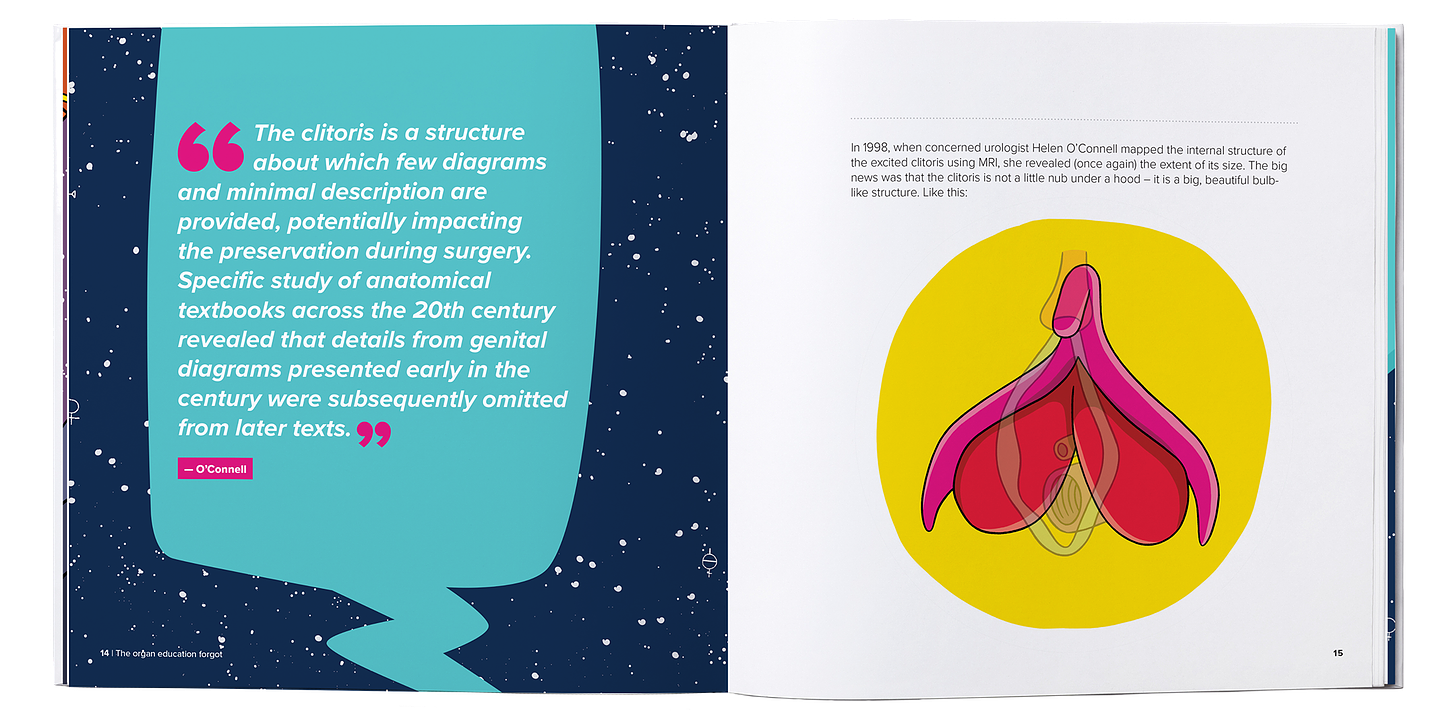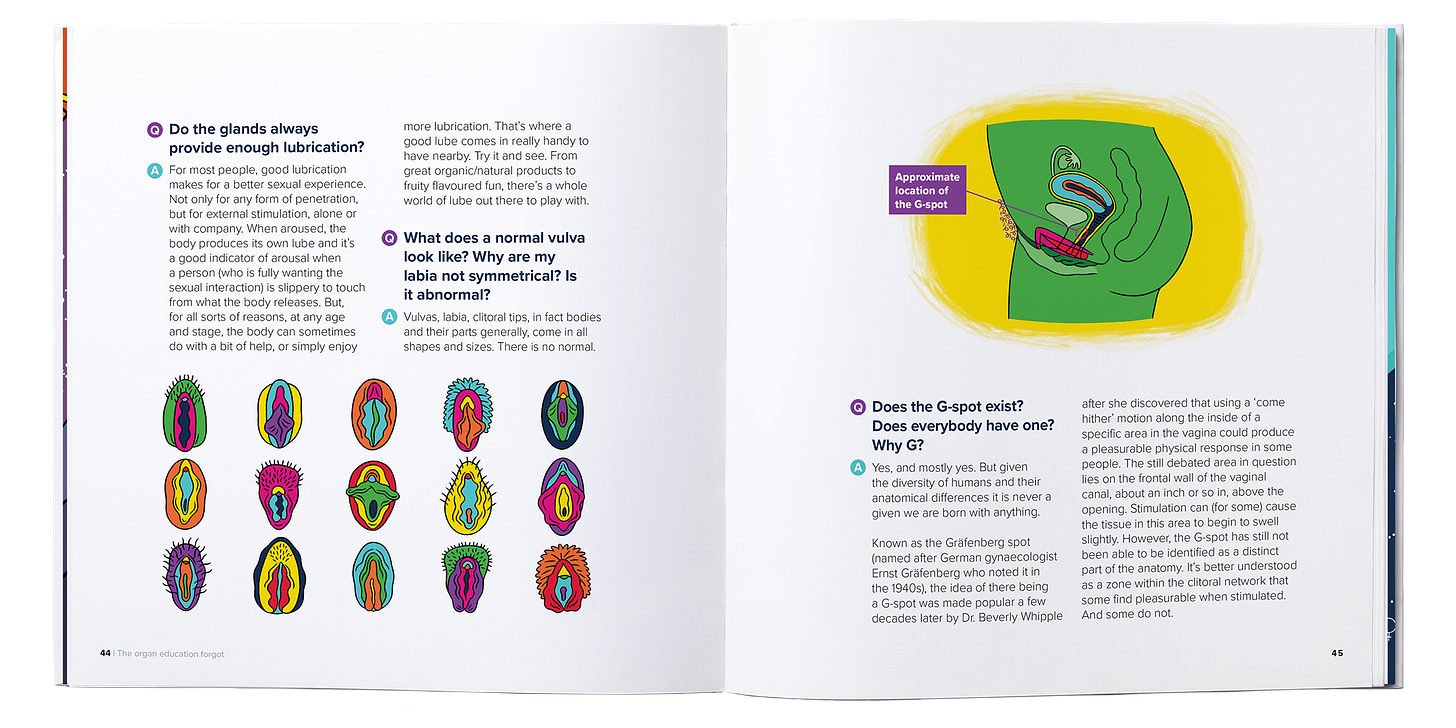“In the workshop we were asked to look at our vaginas with hand mirrors. Then, after careful examination, we were to verbally report to the group what we saw. I must tell you that up until this point everything I knew about my vagina was based on hearsay or invention. I had never really seen the thing. It had never occurred to me to look at it.” - The Vagina Monologues by Eve Ensler, 2009.
Dr Jane Cherrington wants you to know more about your clitoris. Well, not just you - everyone. And she’s written a book aimed at “everyone aged eight to eighty” all about that wonderful little organ we know and love.
It’s a sunny afternoon and I’ve been talking about the clitoris for 40 minutes. I’m just so excited to be able to ask questions about my favourite organ. Did you know the first comprehensive anatomical study of the clitoris wasn’t until 1998?
Did you know the clitoris extends beneath the pubic bone and is wrapped around the vaginal opening? The nerve-rich nub you can see and feel is only a tiny part of this beautiful organ.
Don’t feel bad if you didn’t know that, there have been just 11 medical and scientific articles that focus on the clitoris published worldwide since 1947. The curriculum to be a fellow of the Royal Australian and New Zealand College of Obstetricians and Gynaecologists doesn’t even specifically look at the function of the clitoris.
I was late to understanding the clitoris (mine and every other clitoris I have come to know). Growing up without sexual education, in a purity culture context, meant I felt only shame and a gnawing sense of unease when I thought about my genitals.
Everything from navel to knee was a mystery to me. It wasn’t until after I’d had my babies that I had to fully face (so to speak) what was going on down there.
It coincided with working at a sex shop - a toxic environment in terms of office culture, but also one of the greatest learning opportunities a gal could hope for. I dabbled, really dabbled, and discovered a lot about my body that I’d simply not known.
So, I’m never surprised when I hear that not everybody who has a clitoris knows where it is or exactly what it is.
Enter: Dr Cherrington.
Dr Cherrington runs the amazing collective Sex in Space. An “old hippy from way back”, Dr Cherrington is all about creating spaces to really talk about sex. During the first Covid 19 lockdown she began The Sex Project. The aim was to provide bite-sized bits of information for those hungry to know more about sex and sexuality.
But where to begin?
“We don’t even get taught about an organ in our body, the clitoris. So I thought, let’s start there,” she says.
The Sex Project and Sex in Space podcast has lofty goals, “the broader intent of the project is to open spaces to allow people to think about sex and to talk about and understand sex and sexuality in all of its wonderful forms. We find it very difficult to talk about sex so it has become a sort of sex education project by proxy. We want to encourage and open spaces to have conversations and help people to become educated.”
Jokes about where the clitoris is and how it’s impossible to find, have been around for what feels like forever. It’s an extremely hetero conversation where a cis man’s inability to bring pleasure to his cis woman partner is laughed away. But the organ education gap is no joke. And there are consequences to not educating people about their own bodies or the bodies of others.
When invited to label female genitalia in research, only 9% of respondents could do it correctly. 37% mislabelled the clitoris, even though 89% of participants were women.
“Most people don’t even know the clitoris is an actual organ, that it is hidden under the surface. That lack of knowledge has really big impacts, from women with clitoral nerve damage because some surgeons aren’t educated to kids that can’t name their own body parts which means not being able to communicate about them”.
There’s also the orgasm gap. “You can’t know how something works if you don’t know what it is,” Dr Cherrington says.
Talking to your kids about sex and sexuality seems like a no-brainer for most of us, but the reality is that even if we feel like we’re covering all the birds and all the bees, we might be leaving out the clitoris in our nature talks.
“A lot of people say: ‘We don’t know how to speak to our kids about it’, Dr Cherrington says. “Even my leftie liberal friends, they just don’t have it in them to do that well even though they want to”.
The aim of the Sex Project, and the first book published by the collective - The Organ Education Forgot - is to “open windows into different worlds of sex and sexuality. You can start to have to less judgement if you understand,” Dr Cherrington says.
“We want to give literal tools to demistify and unpack important things like the clitoris. We want to give parents the tools to do things like talk with your kids about porn. We know we need to self educate that gap.”
The Organ Education Forgot is a book you can read with your kids, Dr Cherrington says. The aim is to learn together. “You can comfortably share with your kids and talk it through with them.”
“It’s an entry point for conversation about bodies at a time when children are still interested. They’re interested in bodies even if they’re not interested in talking about sex,” Dr Cherrington says. And the research backs her up.
Discussions about body parts (and yes, that includes the clitoris) should begin in an age and developmentally appropriate and evidence-based way from birth.
Guidelines suggest from the ages of five to eight, children should know what words to use when talking about body parts for all genders. That means: penis, testicles, scrotum, anus, vulva, labia, vagina, clitoris, uterus and ovaries.
“If they don’t have the words to name their own body parts then they can’t relate information to their parents or health professionals.”
“The better the sex education the better the outcomes. Education works. And that’s the driver.”
“There are very human impacts when we don’t educate children and adults about their bodies”.
Quality sexuality education has been shown to help to prevent and reduce the risks of young pregnancy, HIV, and sexually transmitted infections for teenagers.
“Knowledge changes lives because it helps us to understand ourselves and each other. But at our most intimate we are often our most inarticulate. The most poignant strand of feedback we have had about this book was from adults who had come through the abstinence space. They are so thirsty for knowledge and have been so damaged by their lack of knowledge. That’s what keeps us doing this work”.
“If I can’t make a positive difference in the world I might as well give it up.”
The Organ Education Forgot by the Sex in Space team is available to buy online. 10% of all profits will support children orphaned by AIDS.
Bonus cool clit facts:
The clitoris is located where the labia minora (inner lips) meet and extends along both sides of the vagina. It can be found right under the point where the inner labia meet and form a little hood (the clitoral hood). It’s above the vagina (the big hole*) and the urethra (the pee hole**).
Only a fifth (or less) is visible (glans) while the rest is hidden under the skin.
What you can see under that clitoral hood is the glans. It’s just the tip of the clitoris. Some are as small a pea or as big as a thumb.
The dorsal nerve, which consists of two symmetrical, tube-like structures, is the main nerve responsible for clitoral sensation.
Researchers recently found that the human clitoris contains 10,281 nerve fibers on average. This result is about 20% higher than the conventional estimate of 8,000 nerve fibers. The previous estimate was based on a study in cows.
We have trans men and trans masculine non binary folks to thank for our new understanding of the clitoris. The researchers who discovered how many nerve fibers the organ has obtained clitoris tissue samples from seven transmasculine volunteers who were undergoing a gender-affirming procedure known as phalloplasty.
The clitoris can form a penis – and vice versa. In some forms of gender confirmation surgery, the clitoris can be enlarged with hormones to form a penis. In other cases, the penile glans can be reduced in size and relocated to create a clitoris.
It grows! When you start puberty your clitoris begins to increase in size. It can become 1.8 times bigger by the time puberty ends. It grows even more after menopause - up to seven times the size it was at birth.
It’s the only organ in the body that is purely designed for pleasure!
*I’m sorry.
**Really sorry.
I really wanted to include a montage of real clitorises but I could not find even one real clitoris online that wasn’t in porn. The closest I came to was a Youtube video about the differences in sizes of clitorises which would have been cool except it gave fetish vibes as the women were naked when they could have really been wearing tops at least….Meanwhile, I get sent dicks every other day FML.







"The previous estimate was based on a study in cows."
WTF!?!?
The gap in understanding of women’s bodies and health is unbelievable. It’s bonkers that a part of female anatomy didn’t even have a medical study until the 90s!
I remember explaining to a girl in my class when we were in 6th form where her clitoris, vulva, vagina and urethra were. She had no idea she had three holes and the clitoris just baffled her. She’d been having a period for four years and thought her wee and menstrual blood came from the same place.